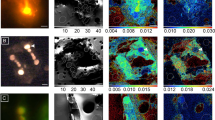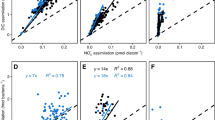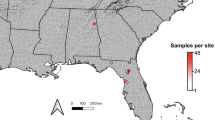Abstract
Filamentous nitrogen fixing cyanobacteria are key players in global nutrient cycling, but the relationship between CO2- and N2-fixation and intercellular exchange of these elements remains poorly understood in many genera. Using high-resolution nanometer-scale secondary ion mass spectrometry (NanoSIMS) in conjunction with enriched H13CO3− and 15N2 incubations of Anabaena oscillarioides, we imaged the cellular distributions of C, N and P and 13C and 15N enrichments at multiple time points during a diurnal cycle as proxies for C and N assimilation. The temporal and spatial distributions of the newly fixed C and N were highly heterogeneous at both the intra- and inter-cellular scale, and indicative of regions performing active assimilation and biosynthesis. Subcellular components such as the neck region of heterocycts, cell division septae and putative cyanophycin granules were clearly identifiable by their elemental composition. Newly fixed nitrogen was rapidly exported from heterocysts and was evenly allocated among vegetative cells, with the exception of the most remote vegetative cells between heterocysts, which were N limited based on lower 15N enrichment. Preexisting functional heterocysts had the lowest levels of 13C and 15N enrichment, while heterocysts that were inferred to have differentiated during the experiment had higher levels of enrichment. This innovative approach, combining stable isotope labeling and NanoSIMS elemental and isotopic imaging, allows characterization of cellular development (division, heterocyst differentiation), changes in individual cell composition and cellular roles in metabolite exchange.
Similar content being viewed by others
Log in or create a free account to read this content
Gain free access to this article, as well as selected content from this journal and more on nature.com
or
References
deBoer P, Crossley R, Rothfield L . (1992). The essential bacterial cell-division protein FtsZ is a GTPase. Nature 359: 254–256.
Erickson HP . (1997). FtsZ, a tubulin homologue in prokaryotic cell division. Trends Cell Biol 7: 362–367.
Flores E, Herrero A, Wolk CP, Maldener I . (2006). Is the periplasm continuous in filamentous multicellular cyanobacteria? Trends Microbiol 14: 439–443.
Ghigo J, Beckwith J . (2000). Cell division in Escherichia coli: role of FtsL domains in septal localization, function, and oligomerization. J Bacteriol 182: 116–129.
Gotto JW, Tabita FR, Van Baalen C . (1979). Mutants of Anabaena strain CA altered in their ability to grow under nitrogen-fixing conditions. J Bacteriol 140: 327–333.
Herrero A, Muro-Pastor AM, Flores E . (1979). Nitrogen control in cyanobacteria. J Bacteriol 183: 411–425.
Klint J, Rasmussen U, Bergman B . (2007). FtsZ may have dual roles in the filamentous cyanobacteria Nostoc/Anabaena sp. strain PCC 7120. J Plant Physiol 164: 11–18.
Kumar A, Tabita FR, Van Baalen C . (1983). High endogenous nitrogenase activity in isolated heterocysts of Anabaena sp. strain CA after nitrogen starvation. J Bacteriol 155: 493–497.
Lechene C, Hillion F, McMahon G, Benson D, Kleinfeld AM, Kampf JP et al. (2006). High-resolution quantitative imaging of mammalian and bacterial cells using stable isotope mass spectrometry. J Biol 5: 20.
Mazouni K, Domain F, Cassier-Chauvat C, Chauvat F . (2004). Molecular analysis of the key cytokinetic components of cyanobacteria: FtsZ, ZipN and MinCDE. Mol Microbiol 52: 1145–1158.
Meeks JC, Elhai J . (2002). Regulation of cellular differentiation in filamentous cyanobacteria in free living plants and plant-associated symbiotic growth states. Microbiol Mol Biol Rev 66: 94–121.
Meeks JC, Wolk CP, Thomas J, Lockau W, Shaffer PW, Austin SM et al. (1977). The pathways of assimilation of 13NH4+ by the cyanobacterium Anabaena cylindrica. J Biol Chem 252: 7894–7900.
Murry MA, Hallenbeck PC, Benemann JR . (1984). Immunochemical evidence that nitrogenase is restricted to the heterocysts in Anabaena cylindrica Arch. Microbiology 137: 194–199.
Simon RD . (1987). Inclusion bodies in the cyanobacteria: cyanophycin, polyphosphate, polyhedral bodies. In: Fay P, Van Baalen C (eds). The Cyanobacteria. Elsevier: Amsterdam, pp 199–225.
Smith RL, Van Baalen C, Tabita FR . (1987). Alteration of the Fe protein of nitrogenase by oxygen in the cyanobacteium Anabaena sp. strain CA. J Bacteriol 169: 2537–2542.
Stewart WDP . (1973). Nitrogen fixation by photosynthetic microorganisms. Annu Rev Microbiol 27: 283–316.
Thomas J, Meeks JC, Wolk CP, Shaffer PW, Austin SM . (1977). Formation of glutamine from [13N] ammonia, [13N] dinitrogen, and [14C] glutamate by heterocysts isolated from Anabaena cylindrica. J Bacteriol 129: 1545–1555.
Thomas J, Wolk CP, Shaffer PW, Austin SM, Galonsky A . (1975). The initial organic products of fixation of 13N-labeled nitrogen gas by the blue-green alga Anabaena cylindrica. Biochem Biophys Res Commun 67: 501–507.
Walsby A . (1972). Structure and function of gas vacuoles. Bacteriol Rev 36: 1–32.
Wolk CP . (1968). Movement of carbon from vegetative cells to heterocysts in Anabaena cylindrica. J Bacteriol 96: 2138–2143.
Wolk CP . (1996). Heterocyst formation. Annu Rev Genet 30: 59–78.
Wolk CP . (2000). Heterocyst formation in Anabaena. In: Brun YV, Shimkets LJ (eds). Prokaryotic Development. Amer Soc Microbiol Press: Washington, DC, pp 83–104.
Wolk CP, Thomas J, Shaffer PW, Austin SM, Galonsky A . (1976). Pathway of nitrogen metabolism after fixation of 13N-labeled nitrogen gas by the cyanobacterium Anabaena cylindrica. J Biol Chem 251: 5027–5034.
Wolk CP, Austin SM, Bortins J, Galonsky A . (1974). Autoradiographic localization of 13N after fixation of 13N-labeled nitrogen gas by a heterocyst-forming blue-green alga. J Cell Biol 61: 440–453.
Acknowledgements
We thank Christina Ramon (LLNL) for invaluable assistance in preparing samples for NanoSIMS analysis, Troy Gunderson (USC) for his assistance with the isotope enrichment component of this study and for the IRMS analysis and Larry Nittler (LLNL) for software development. Work was funded in part by the US Department of Energy Office of Biological and Environmental Research Genomics: GTL research program (RP, PKW, JP, SJF, IDH and KHN). Work was performed at LLNL under the auspices of the US Department of Energy under Contract W-7405-Eng-4. DGC also thanks NSF Division of Ocean Sciences for research support.
Author information
Authors and Affiliations
Corresponding author
Rights and permissions
About this article
Cite this article
Popa, R., Weber, P., Pett-Ridge, J. et al. Carbon and nitrogen fixation and metabolite exchange in and between individual cells of Anabaena oscillarioides. ISME J 1, 354–360 (2007). https://doi.org/10.1038/ismej.2007.44
Received:
Revised:
Accepted:
Published:
Issue date:
DOI: https://doi.org/10.1038/ismej.2007.44
Keywords
This article is cited by
-
Chemotaxis increases metabolic exchanges between marine picophytoplankton and heterotrophic bacteria
Nature Microbiology (2023)
-
The rate and fate of N2 and C fixation by marine diatom-diazotroph symbioses
The ISME Journal (2022)
-
Cell-specific measurements show nitrogen fixation by particle-attached putative non-cyanobacterial diazotrophs in the North Pacific Subtropical Gyre
Nature Communications (2022)
-
Heterogeneous nitrogen fixation rates confer energetic advantage and expanded ecological niche of unicellular diazotroph populations
Communications Biology (2020)
-
Bidirectional C and N transfer and a potential role for sulfur in an epiphytic diazotrophic mutualism
The ISME Journal (2020)



